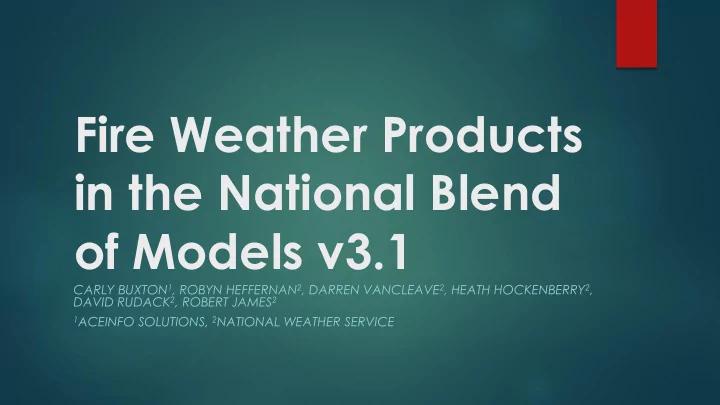

Fire Weather Products in the National Blend of Models v3.1 CARLY BUXTON 1 , ROBYN HEFFERNAN 2 , DARREN VANCLEAVE 2 , HEATH HOCKENBERRY 2 , DAVID RUDACK 2 , ROBERT JAMES 2 1 ACEINFO SOLUTIONS, 2 NATIONAL WEATHER SERVICE
The National Blend of Models (NBM) v3.1 Implemented October 2018 Based on a blend of both NWS and non-NWS numerical weather prediction model data and post-processed model guidance The goal of the NBM is to create a highly accurate, skillful and consistent starting point for the gridded forecast New in NBM v3.1 Additional global and mesoscale models (ECMWF, HRRR-Extended) New Aviation, Fire Weather, Water Resources, and Marine elements Text products for stations (using NBM’s nearest grid point to the station)
Fire Weather Elements NBM v3.1 fire weather grids create nationally consistent fire weather and smoke guidance Coordinated effort through National Fire Weather Program, National Interagency Fire Center, Western Region science officers Will be used by WFO forecasters to support the wildland fire community in predicting the potential of fire onset and/or spread, and determining the ideal timing for prescribed burns Elements included: Mixing Height Transport Wind speed Transport Wind Direction Ventilation Rate 6-hour maximum Haines Index 6-hour maximum Fosberg Fire Weather Index Model inputs: GFS, NAM, NAM Nest, RAP
Fire Weather Elements Produced for 4 domains: CONUS, 2.5 km Alaska, 3 km Hawaii, 2.5 km Puerto Rico, 1.25 km Guidance will run hourly hourly projections 1-36 hours 3-hourly 39-192 hours 6-hourly 198-270 hours
Fire Weather Elements - examples SPC Critical Fire Weather Day July 3-4, 2018 Eastern Nevada, northwest Arizona, most of Utah, northwest Colorado, and far southern Wyoming dry air mass well-mixed boundary layer sustained south-southwest surface winds of 15-20 mph RH values of 5-20% NBM viewer https://www.weather.gov/mdl/nbm_home
Mixing Height Defined as the location of a capping temperature inversion or statically stable layer of air Signifies the height above the surface up to which a pollutant (such as smoke) can be dispersed Calculated using a modified Stull method (virtual potential temperature) SPC Critical Day forecasts well- mixed boundary layer
Transport Wind Speed Average wind speed throughout the mixed layer Calculated as average wind speed magnitude from surface to mixing height SPC Critical Day forecasts sustained south-southwest surface winds of 15-20 mph
Transport Wind Direction Average wind direction throughout the mixed layer Calculated as vector of average U and average V from surface to mixing height SPC Critical Day forecasts sustained south-southwest surface winds of 15-20 mph
Ventilation Rate Represents the ability of the boundary layer to disperse smoke Product of mixing height and transport wind speed SPC Critical Day: well-mixed boundary layer and 15-20 mph sustained wind speeds
6-hour maximum Haines Index Based on the stability and moisture of the lower atmosphere Intended to measure the potential for existing fires to become large or behave erratically Elevation category based on grid point elevation Low Elevations (< 1000 ft / 305 m) Mid Elevations (1000-3000 ft / 305-914 m) High Elevations (> 3000 ft / 914 m)
6-hour Maximum Fosberg Fire Weather Index Tool for evaluating the potential influence of weather on a wildland fire based on temperature, relative humidity and wind speed Calculated using NBM blended, MAE-weighted 2m temperature, 2m RH, and 10m wind speed FFWI of 50+ is typically significant on a national scale SPC Critical Day forecasts 15-20 mph surface winds and low surface RH
Camp Fire November 8 – November 25, 2018 Over 150,000 acres burned Deadliest and most destructive wildfire in California history Wind speeds enabled rapid spread Map Source: Cal Fire
Camp Fire NBM v3.1 Transport Wind Speed NBM v3.1 6-hour max Fosberg FWI
Woolsey Fire November 8 – November 21, 2018 Over 95,000 acres burned Fueled in part by Santa Ana winds N or NE wind direction Map Source: Cal Fire
Woolsey Fire – Santa Ana winds NBM v3.1 Transport Wind NBM v3.1 Transport Wind Direction Speed
Additional developments for NBM v3.2 More models added HRRR, HRRR-Extended, RAP-Extended WRF-ARW, WRF-MEM2, and NEMS-NMMB ECMWFD and ECMWFE Downward Solar Radiation Flux (surface) Precipitation Duration
Questions? Further information on the National Blend of Models can be found at: https://www.weather.gov/mdl/nbm_home
Recommend
More recommend